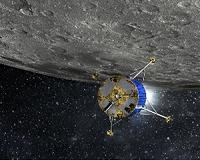 |
Paris (AFP) Sept 21, 2010 The discovery of water on the Moon could affect a telescope that will be installed on China's first lunar lander, scheduled in 2013, a Chinese astronomer was quoted as saying on Tuesday. In September 2009, scientists announced they had found a watery dew covering parts of the Moon. In sunlight, the water vaporises and is then broken down into molecules of hydroxyl, a compound comprising one atom of hydrogen and one oxygen. These hydroxyl levels could have a serious impact on lunar observatories, Chinese astronomers said in a paper to be presented at the European Planetary Science Congress in Rome on Tuesday. "We recalculated the amount of hydroxyl molecules that would be present in the lunar atmosphere and found that it could be two or three orders higher than previously thought," said Zhao Hua of the Chinese Academy of Sciences, according to a press release. This has important ramifications for China's third lunar probe, Chang'e-3, which is designed to land on the Moon in 2013 with an ultraviolet telescope on board. The equipment would operate on the Moon's sunlit surface, powered by solar panels. "At certain ultraviolet wavelengths, hydroxyl molecules cause a particular kind of scattering, where photons (particles of light) are absorbed and rapidly re-emitted," Zhao said. "Our calculations suggest that this scattering will contaminate observations by sunlit telescopes." The press release was issued by the conference's organisers, Europlanet Research Infrastructure, a space research programme backed by the European Commission. As recently as Friday, China's state media said the country was well on track for carrying out its ambitious lunar programme. The first lunar probe, Chang'e-1, orbited the Moon in October 2007, taking high-resolution pictures. The next step is Chang'e-2, which will swing to within 15 kilometres (nine miles) of the Moon, testing soft-landing technologies in preparation for Chang'e-3. A "trial flight mission" of Chang'e-2 is planned by the end of the year, the People's Daily reported last Friday. The Chang'e programme, named after a mythical Chinese goddess who flew to the Moon, plays a pathfinder role in a strategy to bring a lunar rock back to Earth in 2017 and follow this with a manned mission in 2020. Chinese scientists ultimately plan to build a lunar observatory, previous reports have said. Astronomers have dreamt of placing an observatory on the Moon ever since the dawn of the Space Race in the 1950s. The Moon's perceived attractions included lack of seismic activity and -- until the discovery of the dew -- no atmospheric vapour to compromise visual observations. Radio astronomy would not be affected by the higher hydroxyl levels, although a radio telescope would ideally be placed on the far side of the Moon so that it is permanently shielded from interference from TV and radio signals from Earth.
Share This Article With Planet Earth
Related Links Mars News and Information at MarsDaily.com Lunar Dreams and more
 Astrium Investigates Automatic Landing At The Moon's South Pole
Astrium Investigates Automatic Landing At The Moon's South PoleBerlin, Germany (SPX) Sep 20, 2010 Astrium, Europe's leading space company, has won a new competitive contract from the European Space Agency (ESA), as a follow-up to the Next Exploration Science and Technology (NEXT) study to develop a Lunar Lander. The Lunar Lander Phase B1 study will aim to complete the mission design for landing an automated vehicle near the south pole of the Moon. The new contract, valued at euros 6.5 ... read more |
|
| The content herein, unless otherwise known to be public domain, are Copyright 1995-2010 - SpaceDaily. AFP and UPI Wire Stories are copyright Agence France-Presse and United Press International. ESA Portal Reports are copyright European Space Agency. All NASA sourced material is public domain. Additional copyrights may apply in whole or part to other bona fide parties. Advertising does not imply endorsement,agreement or approval of any opinions, statements or information provided by SpaceDaily on any Web page published or hosted by SpaceDaily. Privacy Statement |